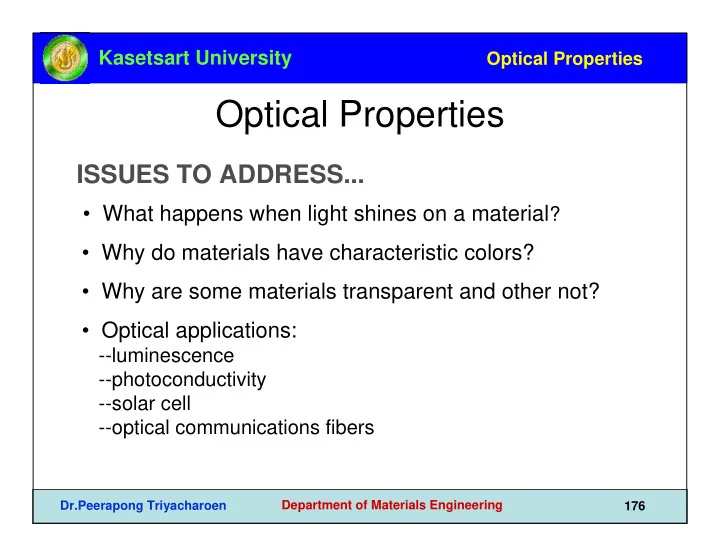

Kasetsart University Optical Properties Optical Properties ISSUES TO ADDRESS... • What happens when light shines on a material ? • Why do materials have characteristic colors? • Why are some materials transparent and other not? • Optical applications: --luminescence --photoconductivity --solar cell --optical communications fibers Department of Materials Engineering Dr.Peerapong Triyacharoen 176
Kasetsart University Optical Properties Light Interaction With Solids • Incident light is either reflected, absorbed, or I o = I T + I A + I R transmitted: Absorbed: IA Reflected: IR Transmitted: IT Incident: Io • Optical classification of materials: Transparent Transluscent Opaque Department of Materials Engineering Dr.Peerapong Triyacharoen 177
Kasetsart University Optical Properties Optical Properties Of Metals : Absorption • Absorption of photons by electron transition: Energy of electron unfilled states n o t o h p ∆ E = h ν required! t n h ν e d i y c g n r I e n Io e f o filled states freq. Planck’s constant of (6.63 x 10-34 J/s) incident light • Metals have a fine succession of energy states. • Near-surface electrons absorb visible light. Department of Materials Engineering Dr.Peerapong Triyacharoen 178
Kasetsart University Optical Properties Optical Properties Of Metals: Reflection • Electron transition emits a photon. Energy of electron unfilled states IR “conducting” electron re-emitted ∆ E photon from material surface filled states • Reflectivity = I R /I o is between 0.90 and 0.95. • Reflected light is same frequency as incident. • Metals appear reflective (shiny)! Department of Materials Engineering Dr.Peerapong Triyacharoen 179
Kasetsart University Optical Properties Selected Absorption: Nonmetals • Absorption by electron transition occurs if h ν > E gap Energy of electron unfilled states blue light: h ν = 3.1eV red light: h ν = 1.7eV incident photon Egap energy hn Io filled states • If E gap < 1.8eV, full absorption; color is black (Si, GaAs) • If E gap > 3.1eV, no absorption; colorless (diamond) • If E gap in between, partial absorption; material has a color. Department of Materials Engineering Dr.Peerapong Triyacharoen 180
Kasetsart University Optical Properties Color Of Nonmetals • Color determined by sum of frequencies of --transmitted light, --re-emitted light from electron transitions. • Ex: Cadmium Sulfide (CdS) -- E gap = 2.4eV, -- absorbs higher energy visible light (blue, violet), -- Red/yellow/orange is transmitted and gives it color. • Ex: Ruby = Sapphire (Al 2 O 3 ) + (0.5 to 2) at% Cr 2 O 3 -- Sapphire is colorless (i.e., E gap > 3.1eV) -- adding Cr 2 O 3 : Transmittance (%) 80 sapphire • alters the band gap 70 • blue light is absorbed Ruby 60 • yellow/green is absorbed 50 • red is transmitted wavelength, λ (= c/ ν )( µ m) 40 • Result: Ruby is deep red in color. 0.3 0.5 0.7 0.9 Department of Materials Engineering Dr.Peerapong Triyacharoen 181
Kasetsart University Optical Properties Transmitted Light: Refraction • Transmitted light distorts electron clouds. electron no cloud transmitted transmitted + + distorts light light • Result 1: Light is slower in a material vs vacuum. speed of light in a vacuum Index of refraction (n) = speed of light in a material Material n --Adding large, heavy ions (e.g., lead Lead glass 2.1 can decrease the speed of light. Silica glass 1.46 --Light can be Soda-lime glass 1.51 "bent" Quartz 1.55 Plexiglas 1.49 Polypropylene 1.49 • Result 2: Intensity of transmitted light decreases with distance traveled (thick pieces less transparent!) Department of Materials Engineering Dr.Peerapong Triyacharoen 182
Kasetsart University Optical Properties Application: Luminescence • Process: Energy of electron incident Energy of electron unfilled states emitted unfilled states radiation light Egap Egap filled states filled states re-emission electron occurs transition occurs • Ex: fluorescent lamps “white” light glass coating UV e.g., β -alumina radiation doped w/Europium Department of Materials Engineering Dr.Peerapong Triyacharoen 183
Kasetsart University Optical Properties Application: Photoconductivity • Description: + + Energy of electron Energy of electron unfilled states unfilled states semi Incident conducting Egap conductor: electron radiation Egap filled states filled states - - A. No incident radiation: B. Incident radiation: little current flow increased current flow • Ex: Photodetector (Cadmium sulfide) Department of Materials Engineering Dr.Peerapong Triyacharoen 184
Kasetsart University Optical Properties Application: Solar Cell • p-n junction: • Operation: --incident photon produces hole-elec. pair. P-doped Si --typically 0.5V potential. conductance Si --current increases w/light intensity. electron creation of Si P Si hole-electron light pair Si - - - n-type Si +- p-n junction n-type Si p-type Si + + + p-n junction p-type Si • Solar powered weather station: Si hole B Si Si Si polycrystalline Si B-doped Si Department of Materials Engineering Dr.Peerapong Triyacharoen 185
Kasetsart University Optical Properties Application: Fiber Optics • Design with stepped index of refraction (n): core: silica glass input pulse total internal reflection output pulse w/higher n cladding: glass intensity intensity w/lower n ∆ n enhances shorter path internal reflection time longer paths time broadened! • Design with parabolic index of refraction core: Add graded input pulse total internal reflection output pulse impurity distrib. to make n higher in intensity intensity core center shorter, but slower paths cladding: (as before) time longer, but faster paths time less broadening! • Parabolic = less broadening = improvement! Department of Materials Engineering Dr.Peerapong Triyacharoen 186
Kasetsart University Optical Properties Summary • When light (radiation) shines on a material, it may be: --reflected, absorbed and/or transmitted. • Optical classification: --transparent, translucent, opaque • Metals: --fine succession of energy states causes absorption and reflection. • Non-Metals: --may have full (E gap < 1.8eV) , no (E gap > 3.1eV), or partial absorption (1.8eV < E gap = 3.1eV). --color is determined by light wavelengths that are transmitted or re-emitted from electron transitions. --color may be changed by adding impurities which change the band gap magnitude (e.g., Ruby) • Refraction: --speed of transmitted light varies among materials. Department of Materials Engineering Dr.Peerapong Triyacharoen 187
Recommend
More recommend